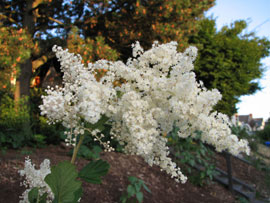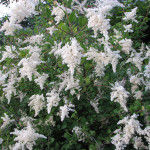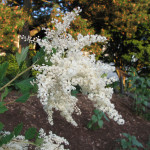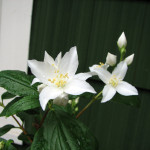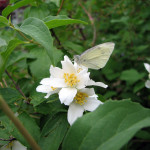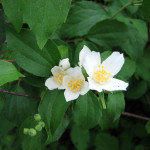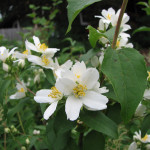Holodiscus discolor
Oceanspray is native to western North America, most commonly found in the mountains of the Pacific Northwest. This fast-growing deciduous shrub gets 8-10′ tall and 3-7′ wide. Its small toothed leaves are 2-4 inches long. Cascading clusters of white flowers drooping from the branches give the plant two of its common names, oceanspray and creambush. The flowers have a faint sugary scent, and each one bears a small, hairy fruit containing one seed which is light enough to be dispersed by wind.
Oceanspray is found in a variety of habitats, from wet coastal forests to drier, cooler mountain peaks further inland. It often grows in areas dominated by Douglas-fir. The plant is found in areas prone to wildfire, such as chaparral communities. It is often the first green shoot to spring up in an area recovering from a burn or logging.
Many small solitary bees, bumblebees, and native butterflies visit this plant for nectar. It can also be considered a pollinator “nursery”, as pale swallowtail, spring azure, Lorquin’s admiral, and brown elfin butterflies all lay their eggs on it.
These attractive shrubs thrive on dry slopes in sun to part-sun, and spread well in favorable conditions. Long-leaf Oregon grape and salal do well in their shade, and they pair well with hazelnut to make a woodland border. Combine with red-flowering currant or vine maple for a deciduous screen.
- Light Requirements: Full Sun, Part Shade, Full Shade
- Water Requirements: Dry, Moist
- Ease of Growing: Easy to grow
- Growth Rate: Fast
- Spreads: Yes
- Wildlife Support: Pollinators, Pest-eating Insects, Birds or Mammals
- Fire-resistant: Yes
- Edible: No
- Mature Height: 8-10ft
- Mature Width:3-7ft
Tall Oregon Grape

Mahonia aquifolium (Berberis aquifolium)
Tall Oregon grape (Mahonia aquifolium) is the state flower of Oregon. The plant is not related to grapes, but gets the name from the purple clusters of berries it produces every fall. Its sharply pointed leaves resemble holly. The bright yellow clusters of flowers in April and May are both a lovely sign of spring, and a welcome sources of nectar for early pollinators including mason bees and bumblebees.
Painted lady butterflies, half-white carpet moths, mining bees, and other insects also use the flowers for food. The berries are eaten by many wildlife, including robins, waxwings, juncos, sparrows, and towhees, as well as foxes, coyotes, and raccoons.
Tall Oregon grape is well suited for low-maintenance plantings or loose evergreen hedges. It grows 5-8 feet tall depending on conditions, so in the garden it serves as a good evergreen backdrop, especially when combined with salal, sword fern, and evergreen hucklebery. Tall Oregon grape tolerates poor soils and summer drought, especially if it has some shade.
- Light Requirements: Full Sun, Part Shade
- Water Requirements: Dry, Moist
- Ease of Growing: Easy to grow
- Growth Rate: Moderate
- Spreads: Yes
- Wildlife Support: Pollinators, Hummingbirds, Pest-eating Insects, Birds or Mammals
- Fire-resistant: Yes
- Edible: Yes
- Mature Height: 5-8ft
- Mature Width:2-8ft
Mockorange

Philadelphus lewisii
Mockorange (Philadelphus lewisii) is an elegant native shrub which grows 3-9 feet tall and has a rounded form. The long stems are red when new and fade to gray with age, the older bark shredding in small flakes. Leaves are usually oval, 1-2 inches long, and a medium green.
White flowers start appearing in clusters at the ends of stems after the plant is 3-4 years old. At the height of bloom, older plants are covered in masses of sweet-smelling flowers, which have a scent similar to orange blossoms with a hint of pineapple.
This plant is as popular with wildlife as it is with people. The indra and pale swallowtail butterflies visit it for nectar, as do hummingbirds and many other pollinators. Tiger swallowtails lay their eggs on it. Birds and small mammals eat the seeds and shelter in the foliage.
Mock-orange’s green leaves turn soft yellow in autumn, contrasting beautifully with the dark green of of evergreen huckleberry and red fall foliage of Western viburnum. Add an understory of sword fern for year-round beauty and wildlife value!
- Light Requirements: Full Sun, Part Shade, Full Shade
- Water Requirements: Dry, Moist
- Ease of Growing: Easy to grow
- Growth Rate: Fast
- Spreads:
- Wildlife Support: Pollinators, Pest-eating Insects, Birds or Mammals
- Fire-resistant: Yes
- Edible: No
- Mature Height: 6-10ft
- Mature Width:4-10ft

